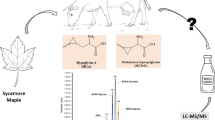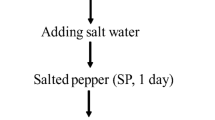Abstract
A liquid chromatographic tandem mass spectrometric (LC–MS–MS) method for the determination of five chemical coccidiostats (decoquinate, diclazuril, halofuginone, nicarbazin, and robenidine) and five ionophore coccidiostats (maduramicin, monensin, narasin, salinomycin, and semduramicin) in yoghurt, kefir, and sour cream is presented. Lasalocid, the sixth ionophore listed in 124/2009/EC was not included because of its extremely dissimilar behavior during sample preparation. Main steps of the method include extraction with acetonitrile, centrifugation, clean-up on Oasis HLB solid phase extraction cartridge, evaporation under nitrogen stream, and LC–MS–MS determination. Selectivity, linearity, sensitivity, accuracy, repeatability, within-laboratory reproducibility, limit of determination, and limit of quantitation were determined during the validation procedure. The method proved to be applicable for both qualitative and quantitative determination of the ten above-mentioned target compounds. In our in-house fermentation experiments, milk fortified with coccidiostats was fermented to get yoghurt, kefir, and sour cream. Our results show that the coccidiostat content did not change significantly during fermentation for any of the target compounds.


Similar content being viewed by others
References
Commission Regulation 1831/2003/EC (2003) Regulation (EC) No 1831/2003 of the European Parliament and of the Council of 22 September 2003 on additives for use in animal nutrition. Off J Eur Union L268:29–43
(2003) Community Register of Feed Additives to Regulation (EC) No. 1831/2003. List of the authorized additives in feedingstuffs (1) published in application of Article 9t (b) of Council Directive 70/524/EEC concerning additives in feedingstuffs. Off J Eur Union C50:1–144
Commission Regulation 124/2009/EC (2009) COMMISSION REGULATION (EC) No 124/2009 of 10 February 2009 setting maximum levels for the presence of coccidiostats or histomonostats in food resulting from the unavoidable carry-over of these substances in non-target feed. Off J Eur Union L40:7–11
Huebra MJG, Vincent U, von Holst C (2010) Determination of semduramicin in poultry feed at authorized level by liquid chromatography single quadrupole mass spectrometry. J Pharm Biomed Anal 53:860–868
Feás X, Vázquez BI, Iglesias A, Cantalapiedra J, Fente CA, Cepeda A (2010) Sensitive determination of decoquinate in milk by high-performance liquid chromatographic coupled to laser-induced fluorescence detection. Food Anal Methods 3:138–143
Matabudul DK, Crosby NT, Lumley I, Sumar S (2001) The optimisation of a rapid method for the determination of lasalocid in poultry feed using supercritical fluid extraction and high performance liquid chromatography. Food Chem Anal Nutr Clin Methods Sect 75:465–471
Matabudul DK, Conway B, Lumley ID (2000) A rapid method for the determination of lasalocid in animal tissues and eggs by high performance liquid chromatography with fluorescence detection and confirmation by LC–MS–MS. Analyst 125:2196–2200
Dusi G, Faggionato L, Gamba V, Baiguera A (2000) Determination of nicarbazin and clopidol in poultry feeds by liquid chromatography. J Chromatogr A 882:79–84
Chéneau E, Henri J, Pirotais Y, Abjean J-P, Roudaut B, Sanders P, Laurentie M (2007) Liquid chromatography–electrospray tandem mass spectrometric method for quantification of monensin in plasma and edible tissues of chicken used in pharmacokinetic studies: applying a total error approach. J Chromatogr B 850:15–23
Mortier L, Daeseleire E, Peteghem CV (2005) Liquid chromatographic tandem mass spectrometric determination of five coccidiostats in poultry eggs and feed. J Chromatogr B 820:261–270
Mortier L, Daeseleire L, Peteghem CV (2005) Determination of the coccidiostat diclazuril in poultry feed and meat by liquid chromatography–tandem mass spectrometry. Anal Chim Acta 529:229–234
Yakkundi S, Cannavan A, Elliott CT, Lövgren T, Kennedy DG (2003) Development and validation of a method for the confirmation of halofuginone in chicken liver and eggs using electrospray tandem mass spectrometry. J Chromatogr B 788:29–36
Cannavan A, Ball G, Kennedy G (1999) Determination of nicarbazin in feeds using liquid chromatography–electrospray mass spectrometry. Analyst 124:1431–1434
Mortier L, Daeseleire E, Delahaut P (2003) Simultaneous detection of five coccidiostats in eggs by liquid chromatography–tandem mass spectrometry. Anal Chim Acta 483:27–37
Vincent U, Ezerskis Z, Chedin M, von Holst C (2011) Determination of ionophore coccidiostats in feeding stuffs by liquid chromatography-tandem mass spectrometry. Part II. Application to cross-contamination levels and non-targeted feed. J Pharm Biomed Anal 54:526–534
Thompson TS, Noot DK, Kendall JD (2011) Determination of ionophores in raw bovine milk using LC–MS/MS: application to residue surveillance. Food Chem 127:321–326
Vincent U, Chedin M, Yasar S, von Holst C (2008) Determination of ionophore coccidiostats in feedingstuffs by liquid chromatography–tandem mass spectrometry. Part I. Application to targeted feed. J Pharm Biomed Anal 47:750–757
Matabudul DK, Conway B, Lumley I, Sumar S (2001) The simultaneous determination of the ionophore antibiotics in animal tissues and eggs by tandem electrospray LC–MS–MS. Food Chem 75:345–354
Dusi G, Gamba V (1999) Liquid chromatography with ultraviolet detection of lasalocid, monensin, salinomycin and narasin in poultry feeds using pre-column derivatization. J Chromatogr A 835:243–246
Shao B, Wu X, Zhang J, Duan H, Chu X, Wu Y (2009) Development of a rapid LC–MS–MS method for multi-class determination of 14 coccidiostat residues in eggs and chicken. Chromatographia 69:1083–1088
Dubreil-Chéneau E, Bessiral M, Roudaut B, Verdon E, Sanders P (2009) Validation of a multi-residue liquid chromatography–tandem mass spectrometry confirmatory method for 10 anticoccidials in eggs according to Commission Decision 2002/657/EC. J Chromatogr A 1216:8149–8157
Galarini R, Fioroni L, Moretti S, Pettinacci L, Dusi G (2011) Development and validation of a multi-residue liquid chromatography-tandem mass spectrometry confirmatory method for eleven coccidiostats in eggs. Anal Chim Acta 700:167–176
Olejnik M, Szprengier-Juszkiewicz T, Jedziniak P (2010) Confirmatory method for determination of coccidiostats in eggs. Bull Vet Inst Pulawy 54:327–333
Cronly M, Behan P, Foley B, Malone E, Shearan P, Regan L (2010) Determination of eleven coccidiostats in animal feed by liquid chromatography–tandem mass spectrometry at cross contamination levels. Anal Chim Acta 700:26–33
Boscher A, Guignard C, Pellet T, Hoffmann L, Bohn T (2010) Development of a multi-class method for the quantification of veterinary drug residues in feedingstuffs by liquid chromatography–tandem mass spectrometry. J Chromatogr A 1217:6394–6404
Dubois M, Pierret G, Delahaut Ph (2004) Efficient and sensitive detection of residues of nine coccidiostats in egg and muscle by liquid chromatography–electrospray tandem mass spectrometry. J Chromatogr B 813:181–189
Olejnik M, Szprengier-Juszkiewicz T, Jedziniak P (2009) Multi-residue confirmatory method for the determination of twelve coccidiostats in chicken liver using liquid chromatography tandem mass spectrometry. J Chromatogr A 1216:8141–8148
Commission Decision 2002/657/EC (2002) Commission Decision of 12 August 2002 implementing Council Directive 96/23/EC concerning the performance of analytical methods and the interpretation of results. Off J Eur Communities L221:8–36
Beier RC, Stanker LH (1998) 4,4′-Dinitrocarbanilide—hapten development utilizing molecular models. Anal Chim Acta 376:139–143
Acknowledgments
This work was supported by Wessling International Research and Educational Center. We also wish to express our special thank for Kromat Ltd. for providing the LC–MS–MS instrument. We gratefully acknowledge Janssen for kindly donating diclazuril-bis and Merck Ltd. for providing the chemicals.
Author information
Authors and Affiliations
Corresponding author
Rights and permissions
About this article
Cite this article
Nász, S., Károlyné, E.M., Rikker, T. et al. Determination of Coccidiostats in Milk Products by LC–MS and Its Application to a Fermentation Experiment. Chromatographia 75, 645–653 (2012). https://doi.org/10.1007/s10337-012-2236-2
Received:
Revised:
Accepted:
Published:
Issue Date:
DOI: https://doi.org/10.1007/s10337-012-2236-2




